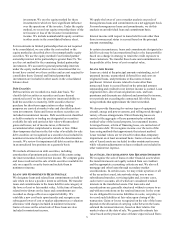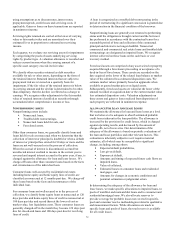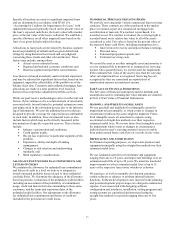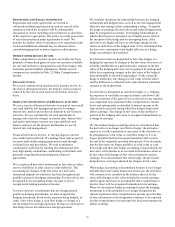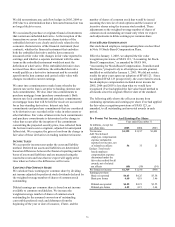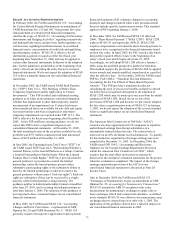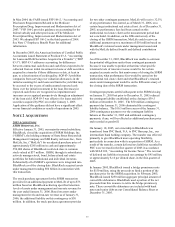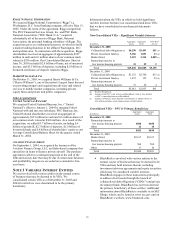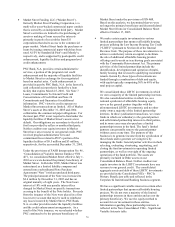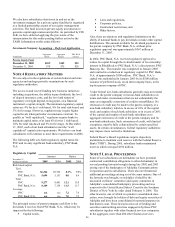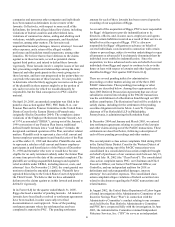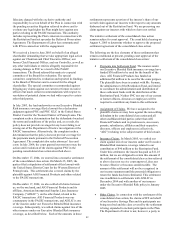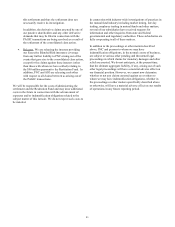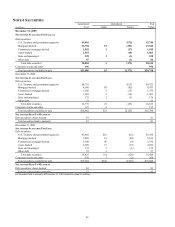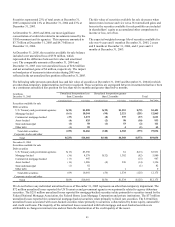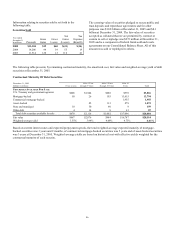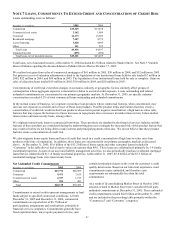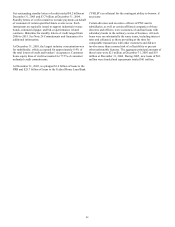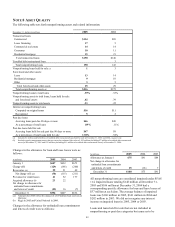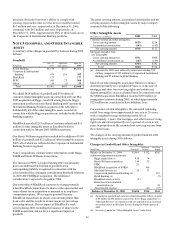PNC Bank 2005 Annual Report Download - page 80
Download and view the complete annual report
Please find page 80 of the 2005 PNC Bank annual report below. You can navigate through the pages in the report by either clicking on the pages listed below, or by using the keyword search tool below to find specific information within the annual report.
80
We also have subsidiaries that invest in and act as the
investment manager for a private equity fund that is organized
as a limited partnership as part of our equity management
activities. The fund invests in private equity investments to
generate capital appreciation and profits. As permitted by FIN
46R, we have deferred applying the provisions of the
interpretation for this entity pending further action by the
FASB. Information on this entity follows:
Investment Company Accounting – Deferred Application
In millions
Aggregate
Assets
Aggregate
Equity
PNC Risk
of Loss
Private Equity Fund
December 31, 2005 $109 $109 $25
December 31, 2004 $78 $76 $20
NOTE 4 REGULATORY MATTERS
We are subject to the regulations of certain federal and state
agencies and undergo periodic examinations by such
regulatory authorities.
The access to and cost of funding new business initiatives
including acquisitions, the ability to pay dividends, the level
of deposit insurance costs, and the level and nature of
regulatory oversight depend, in large part, on a financial
institution’ s capital strength. The minimum regulatory capital
ratios are 4% for tier 1 risk-based, 8% for total risk-based and
3% for leverage. However, regulators may require higher
capital levels when particular circumstances warrant. To
qualify as “well capitalized,” regulators require banks to
maintain capital ratios of at least 6% for tier 1 risk-based,
10% for total risk-based and 5% for leverage. At December
31, 2005, each of our bank subsidiaries met the “well
capitalized” capital ratio requirements. We believe our bank
subsidiaries will continue to meet these requirements in 2006.
The following table sets forth regulatory capital ratios for
PNC and its only significant bank subsidiary, PNC Bank,
N.A.
Regulatory Capital
Amount Ratios
December 31
Dollars in millions 2005 2004
2005
2004
Risk-based capital
Tier 1
PNC $6,364 $5,794 8.3%
9.0%
PNC Bank, N.A. 5,694 5,151 8.0 8.4
Total
PNC 9,277 8,401 12.1 13.0
PNC Bank, N.A. 8,189 7,158 11.5 11.7
Leverage
PNC n/a n/a
7.2 7.6
PNC Bank, N.A. n/a n/a
7.0 7.2
The principal source of parent company cash flow is the
dividends it receives from PNC Bank, N.A., which may be
impacted by the following:
• Capital needs,
• Laws and regulations,
• Corporate policies,
• Contractual restrictions, and
• Other factors.
Also, there are statutory and regulatory limitations on the
ability of national banks to pay dividends or make other capital
distributions. The amount available for dividend payments to
the parent company by PNC Bank, N.A. without prior
regulatory approval was approximately $567 million at
December 31, 2005.
In 2004, PNC Bank, N.A. received regulatory approval to
reduce its capital through the in-kind transfer of its ownership
interest in BlackRock to PNC Bank, N.A.’ s direct parent, PNC
Bancorp, Inc. This transfer was completed in January 2005
and resulted in a reduction in regulatory capital for PNC Bank,
N.A. of approximately $500 million. PNC Bank, N.A.’ s
capital was replenished in January 2005 by its $500 million
issuance of preferred stock, on an intercompany basis, to the
top tier parent company of PNC.
Under federal law, bank subsidiaries generally may not extend
credit to the parent company or its non-bank subsidiaries on
terms and under circumstances that are not substantially the
same as comparable extensions of credit to nonaffiliates. No
extension of credit may be made to the parent company or a
non-bank subsidiary which is in excess of 10% of the capital
stock and surplus of such bank subsidiary or in excess of 20%
of the capital and surplus of such bank subsidiary as to
aggregate extensions of credit to the parent company and its
non-bank subsidiaries. Such extensions of credit, with limited
exceptions, must be fully collateralized by certain specified
assets. In certain circumstances, federal regulatory authorities
may impose more restrictive limitations.
Federal Reserve Board regulations require depository
institutions to maintain cash reserves with the Federal Reserve
Bank (“FRB”). During 2005, subsidiary banks maintained
reserves which averaged $196 million.
NOTE 5 LEGAL PROCEEDINGS
Some of our subsidiaries are defendants (or have potential
contractual contribution obligations to other defendants) in
several pending lawsuits brought during late 2002 and 2003
arising out of the bankruptcy of Adelphia Communications
Corporation and its subsidiaries. There also are threatened
additional proceedings arising out of the same matters. One of
the lawsuits was brought, on Adelphia’ s behalf by the
unsecured creditors’ committee and equity committee in
Adelphia’ s consolidated bankruptcy proceeding and was
removed to the United States District Court for the Southern
District of New York by order dated February 9, 2006. The
other lawsuits, one of which is a putative consolidated class
action, were brought by holders of debt and equity securities of
Adelphia and have been consolidated for pretrial purposes in
that district court. These lawsuits arise out of lending and
securities underwriting activities engaged in by these PNC
subsidiaries together with other financial services companies.
In the aggregate, more than 400 other financial services



